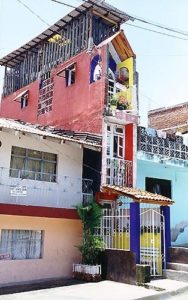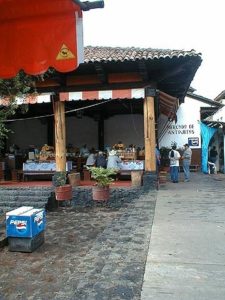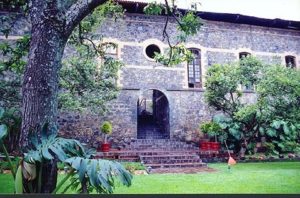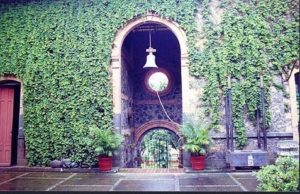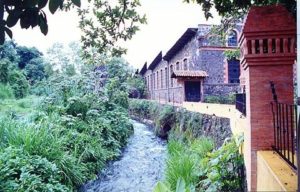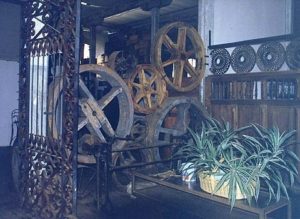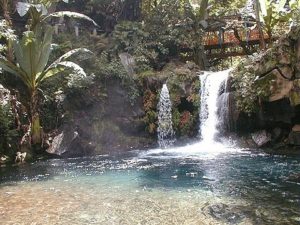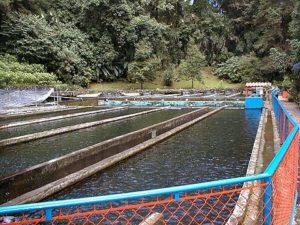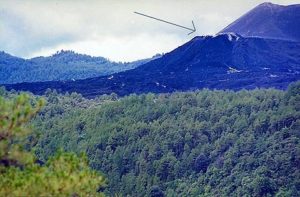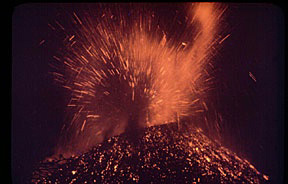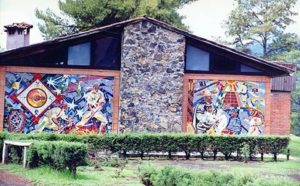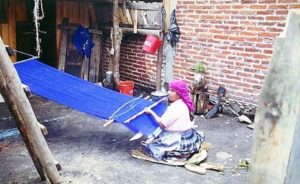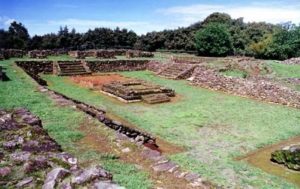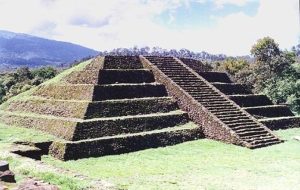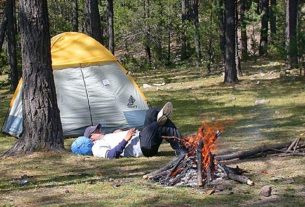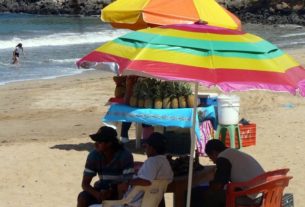They call it “the place where the flowers bloom,” this steamy edge of subtropical landscape, as rich in history as it is in surprise and beauty where superlatives and contrasts abound.
It was the early 80s, and Uruapan was merely a waystation on the road between Morelia and Ixtapa. It struck me as a nice enough agricultural town, with a spanking-new shopping center, some modern neighborhoods, and a deserted but stylish restaurant billed as “La Scala.” At that moment, it bode as much tourist potential as Fresno.
A couple of years later, some friends goaded me into joining them for the Semana Santa arts festival, promising a spectacle of not less than a million or so clay pots piled up in the main plaza. And that’s when my eyes began to open. There really was something more to Uruapan than avocados.
Oaxaca gets all the credit as Mexico’s craft and cultural Mecca. What many folks fail to realize is that Uruapan is a serious competitor in that field, offering up even more. And more easily accessible, too.
At the edge of the high tropics, Uruapan, the second largest city in Michoacán, acts, smells and looks like it ought to be not more than a half-hour’s drive from the ocean. It’s really at least a 6-hour drive through some isolated areas to the Playa Azul, just up the road from Lazaro Cardenas, but a cuota (toll road) due for completion in December 2000, will change all of that.
Nestled at the southern reaches of the Sierras, Uruapan spills onto seemingly endless lush and verdant hills and valleys bearing oranges, bananas, and coconut palms, reminiscent of Hawaii. A five-minute drive to the north or west leads to pine forests which could be set in northern California. The Centro, or downtown area, which really isn’t in the center of town, mixes up architectural styles from colonial times to the 1950s in a style which really reminded me of Istanbul. At one end of the plaza the Hotel Moderna might’ve been the cat’s pajamas back in the early forties, but is now a sad one-star property, but its sign says it all. I hope they never remove that sign. At the opposite sits the swank, full-service Hotel Plaza Uruapan. Even the street names — from Culver City Ave. and the usual spate of historic personages to the exotically unpronounceable — bear witness to the diversity this town harbors. Each direction points to contrasts — in time, in landscape, and in culture. Uruapan is the real and untouted Mexico.
When Fray Juan de San Miguel founded Uruapan in 1533, he divided it up into nine barrios (neighborhoods), which wasn’t a bad idea, given the city’s topography. It also provided an excellent excuse for establishing more chapels and fiestas which endure almost five hundred years later in what was heralded as a feat of some darn good urban planning.
The logical starting place is right downtown at the tree-lined, three-block long Plaza de Morelos y Mártires de Uruapan. The absolute must-see, just north of the plaza, is La Huatapera, built as one of the first hospitals on the American continent (it also served as an inn) around 1534, which now houses the Museum of Popular Arts, a small but excellent representation of the best of Michoacán artesania.
Alongside La Huatapera is the Inmaculada Church, built at the same time. Recently renovated, its ochre and mauve interior spells a soothing and peaceful atmosphere, delicately balanced against Moorish tones. On the other side of La Huatapera is the Casa de la Cultura, where anything from piano competitions to folk dancing may take place. Alongside is the Parroquia de San Francisco, with its breaktaking modern interior.
Directly behind La Huatepera is a small market, quite possibly the cleanest I’ve ever seen in all of Mexico, selling everything from straw hats to produce. Inside this market is the Mercado de Antojitos offering up typical fare, ranging from carnitas to corundas and café de olla. Living in Michoacán where good food’s available all the time, I’ve become jaded, but I’d definitely recommend these stalls for a quick nosh.
Supposedly the narrowest house in the world is but a meter wide and located in Amsterdam, but Uruapan claims to have its very own “narrowest house in the world,” 1.2 meters wide and 10.20 meters deep, located at 50 Carrillo Puerto St., north of Centro. It’s worth a gander, if only because it’s a lot closer than Holland.
A few blocks from the Plaza is the Fabrica San Pedro, a textile factory built in the late 19th century in the style of most textile mills of that era. One of the largest water-powered mills in the region, this factory produced as many as 40,000 blankets during its heyday. Americans Walter and Bundy Illsley, long-time residents, bought the mill in the late eighties, where their company, Telares Uruapan, still produces hand-loomed natural fibers in traditional local as well as custom designs for export all over the world from San Miguel de Allende to Australia. Their restoration of the Fabrica San Pedro is nothing short of marvelous, devoting a portion of the mill to a classy convention center, an upscale gallery and shop overlooking well-manicured gardens fronting the Rio Cupatitzio. Open daily except Sunday. Miguel Trevino S/N. (452) 4-0677. Fax (452) 4-3801.
Just around the corner from the Fabrica San Pedro is the Hosteria del Angel, more than simply a restaurant. The walls lining the angel-filled rooms are a local artist’s renditions of religious scenes from the extraordinary ceilings of the 17th century Tupataro church. Paella on Sundays is a specialty, and the regular menu represents a fusion of Spanish cuisine and nouvelle Mexican. Calle Caracol No. 30, Antiguo Barrio de San Pedro. (452) 313-62. Closed Mondays.
Ask any Mexican what Uruapan instantly brings to mind, and it’s the Parque Nacional Eduardo Ruiz. From the D.F.’s juniors to an ordinary albanil, the opinion remained uniform, forcing me to find out exactly what could possibly be so great about a park with a waterfall. I’d seen it from the Mansion de la Cupatitzio’s restaurant, considered it nothing more than scenery.
Finally, I paid the 6-peso admission to find out for myself. And I was more than amazed. This tropical rainforest, with its neat walks and crashing falls and fountains, demands at least half a day’s worth of exploration. “Park” just doesn’t describe this tropical rainforest and its trails along the Rio Cupatitizio leading up to its beginning at La Rodilla del Diablo (“the Devil’s Knee”), cleaner and more spectacular than any of Walt Disney’s wildest dreams. In the middle of the park is a trout hatchery, where salmon trout could be plucked from the water for 40 pesos per kilo. Within this 542-hectare park were more varieties and permutations of flora than we could identify: including a plátano con huesos, a lumpy sort of banana with fingernail-sized black seeds which was thought to have been brought to Mexico by African slaves.
About seven miles distant, the Cupatitzio reigns over yet another park, where the waterfall of La Tzaráracua makes a hundred-foot plunge, and farther downstream again at a smaller waterfall, Tzararacuita.
Uruapan serves up a year-round menu of cultural events ranging from traditional costume competitions, dance exhibitions, concerts, fiestas, and programs ranging from puppetry to photography. Easter vacation, which is a two-week spring break in Mexico, brings out the best: Tianguis Artesanal del Domingo de Ramos, the Holy Sunday craft market. What started forty years ago as a pottery-only show has grown into an extravaganza of more than 1,200 artisans from throughout the state of Michoacán who really do bring more than a million pieces of their best work to the Plaza de Morelos y Mártires de Uruapan.
Avocado is king in Uruapan, the epicenter of Mexican avocado production, where enormous facilities have sprouted up almost overnight to meet the demand for export to venues as far-flung as Japan and France, and, since an eighty-year old ban was repealed three years ago, to the United States. In fact, the USDA has a dozen inspectors stationed in Uruapan just to make certain that US-exporting companies follow the rules. Leveraging the risks of handling fresh produce, food processing firms have taken the avocado to new heights from pulp processing to marketing frozen products. Mexican growers, satisfying domestic per capita consumption of 18.7 pounds annually, fare behind California-owned avocado exporters.
But there’s more than the makings of guacamole harvested in those verdant hills. Coffee, chocolate, oranges, bananas and macadamias are part of the area’s bounty. Macadamias in Mexico? Only a few years ago, someone discovered that Uruapan’s climate was just right for the nut orchards, and he encouraged its production. Roadside sides just outside of the city sell the shelled nuts for $3 a pound.
The traditional lacquerware of Uruapan never really impressed me until I watched the transformation of a batea (shallow wooden bowl) into a work of art as the maestra explained each step of an arduous and delicate process, selecting the right low-resin wood, grinding pigments from the depths of the earth, mixing it with chia oil, and adding the final and most important ingredient: aje. The aje, she revealed, was a wax derived from boiling an insect found only in Mexico. What distinguishes Uruapan lacquer from the rest of the lot is a technique called embutido, a fine carving of lacquer, hand-rubbed, incised, inlaid, and rubbed with an additional color in successive steps, taking at least a month to complete. Where did the idea for lacquerware come from? Dr. Atl, the artist also known as Gerardo Murillo, offered up the idea that about the year 600 A.D. the Chinese reached the west coast of Michoacán. Designs range from Tarascan to Moorish and even contemporary notes.
PARICUTIN
Paricutín entered my vocabulary back around junior high school, during a science class film about the birth of a volcano discovered by campesino Dionisio Pulido working a cornfield who rushed back to tell the people of his village minutes (or so it seemed) before their church was engulfed in lava. A few years ago, a friend and I decided to drive to Paricutín on the spur of the moment, knowing nothing more than that the more popular Angahuan route surely meant the much-feared and mandatory horseback riding.
We drove to San Juan Nuevo, eight miles down the road from Uruapan, and found ourselves a logging road. By the time we were halfway up the mountain, it started raining, but ever-determined to reach the peak, we made it in about an hour. Of course, the logging truckdrivers headed downhill looked askance at the two fools taking the wrong road up, but the fields of lava entranced us. As we reached the famed steeple mired in lava, some of the necessary undercarriage of our Suburban unwittingly jettisoned on the way, we met a tour bus. Idiots that we were, we’d taken the longer, more arduous route.
Still, San Juan Nuevo bears exploration, if only to understand the transplantation of an entire community some twenty miles away to an ex-hacienda formerly known as Los Conejos. Paricutín began its eruption on 20 February 1943, but the community didn’t get around to dismantling its houses and moving the church contents until over a year later. Ever since then, the people of San Juan Nuevo make a pilgrimage back to the old town of San Juan Parangaricutiro.
Only a year after its birth, Paricutín was a tourist attraction. Gringo folklorista Frances Toor, writing in her New Guide to Mexico (1st ed., 1944) gives complete directions for renting horses, suggesting that tourists “plan to see the volcano by daylight and at night.” By the fifties, when the volcano spewed for the last time, the tourist potential had faded.
Eco-tourism has made Paricutín a hot attraction once more. And there’s a far easier route than the one I took that first time: Angahuan. About twenty miles from Uruapan, it’s an easy drive. Follow the signs leading north to Paracho, turning left toward Los Reyes. Vistas rapidly change from avocado orchards to forested dells, punctuated by trojes, the typical wooden Tarascan dwelling. Most trojes now sport metal roofs, surely more fire-retardant than the traditional wood.
Angahuan is another world entirely, the archetypal Tarascan village, one where a goodly lot of the populace speak Spanish and Tarasco and where everyday attire was straight out of history. Our reverie was cut short by shills on horseback, begging to take us to the volcano, adding, “We speak English.” Our first stop was right downtown to check out the plaza and the church, wondering who owned the underfed sow that just seemed to wander around. The church, dedicated to Santiago de Apostola, bore the date of 1562, was simple, unadorned but for a Plateresque doorway. Inside, Mudéjar touches revealed some definite cross-cultural themes.
Many of the houses bore crosses adorned with children’s clothing and, sometimes, toys. We just couldn’t figure that out until we asked. Each of those crosses had been erected in memory of a child who’d died.
Weaving our way through the town’s dirt roads, we finally found the Centro Turistico de Angahuan, a delightful compound of cabins, camping spots, and, of course, the view of Paricutín. This time, the full glory of the buried church’s front end revealed itself as well as a broad and fertile valley below. The cabins, which rent from $150 pesos per night (without bath) to $400 pesos (with bath), struck us as a genuine bargain. The horses even looked sufficiently tame and well-groomed and I briefly considered renting one for $150 pesos until my friend Hank mentioned something about Christopher Reeves.
Heading out of town, our interest was piqued by the activity going on inside of houses, so we peeked in a few, watching women weave shawls and blankets on backstrap looms. A single article can take a month’s worth of work.
TINGAMBATO
Twenty miles down the libre (free road) from Uruapan to Patzcuaro sits Tingambato, a small farming town known for its archeological ruins dating back to somewhere between 500 to 1000 A.D. Platforms surround a central plaza with multi-chambered pyramids and a ball court distinguishes these ruins from others in western Mexico. Open daily from 10 a.m. to 5 p.m.
Everyone who’d ventured there before me insisted that the Niño Jesus de Tingambato was the town’s leading attraction, so I forayed into the church just to see him. The otherwise elegant but modern church of no exciting architectural note was filled with the faintest sounds of Christmas tunes like “Rudolph the Red-Nosed Reindeer” and “Santa Claus is Coming to Town.” Sure enough, there he sat, dressed in a proper suit, tied to a chair, surrounded by toys and Christmas lights, and to his right was an appropriate number of testimonials to his powers. Taking all of this in, wondering if there really was some charm at work, I took my leave, stepping back on perfectly level flooring and twisted the heck out of my bad ankle. I’m sure a meaning lurks in all of this, but I’m not sure what that meaning is.
PARACHO
About thirty minutes’ north of Uruapan, on a well-paved road meandering through timber country is Paracho, Mexico’s guitar capital. (See https://www.mexicofile.com/acapulco/parachoguitars.htm). If the Museum of the Guitar and concerts just don’t strike your fancy, violins, cellos and furniture are also made in this picture-book town.
GETTING THERE
Uruapan’s airport services domestic routes exclusively, with daily flights from Mexico City, Morelia, Guadalajara, Lazaro Cardenas and Ixtapa. Car rentals are available. Buses to nearly every part of the republic, including the towns mentioned in this article, arrive and depart from Uruapan’s large and modern bus station.
By car, Uruapan is an easy 77 miles from Morelia on a toll road, 281 miles from Mexico City, and 276 from Guadalajara. From Playa Azul, Highway 37 is somewhat more arduous for the time being, but the cuota to Nueva Italia is now complete, and the remaining cuota to Lazaro Cardenas is scheduled for completion in December 2000.
WHERE TO EAT AND STAY
My favorite hotel is Mansion del Cupatitzio, modestly priced and the best in town. 57 rooms surround a heated pool in a garden setting bordering the Parque Eduardo Ruiz. Tel 011-52-4-523-2100, fax (4) 524-6772 [email protected]
The Plaza Uruapan, at Melcho Ocampo 64 on the main plaza, is a 119-room, modern and efficient property, less costly than the Mansion del Cupatitzio. Tel 011-52-4-523-3488, fax 011-52-4-523-3980.
In Angahuan, the Centro Turistico Angahuan, Camino al Volcan Paricutin, has 13 cabins and camping and RV facilities in a truly rustic setting. Tel 011-52-4-50383, fax 011-52-4-33934
SIDEBAR – TARASCA OR PUREPECHA?
Remembering that I’d forgotten to eat, I stopped at Abarrotes Lupita, a small tienda in San Lorenzo in search of junk food. A basket of pan de leña (wood-fired bread) caught my eye instead, and instantly I knew I was in heaven. Eavesdropping on the storekeeper’s chatter with her customers, all clad in the traditional garb of satin and lace blouses and pleated skirts, tying up their purchases in rebozos, I heard no Spanish being spoken. When I asked the storekeeper if they were speaking Purepecha, she upbraided me with a quick, “Tarasca.”
Now I was thoroughly confused, having seen both words used interchangeably. I called upon J. Benedict Warren, who wrote The Conquest of Michoacán and knows more about Tarascan history than anyone, and asked him. I double-checked with Ramiro, the man who works for me, just to be sure. Tarascan really means “of the family,” within the first degree of consanguinity. When the Spaniards’ needed the civilizing influence of a few women, just to get through the night, the native folks referred to them as “in-laws” the next day. Purepecha, meaning campesino or working man, was taken from the indigenous language as part of the nativist movement. But that’s a misnomer, because not all native peoples were campesinos, so it would be a faux paus to call a merchant, king or warrior Purepecha. Some 18th century writers simply got around this by referring to la lengua de Michoacán. Warren pointed out that there was a distinct regional preference. In the Sierras, Tarasca is preferred, while around Lake Patzcuaro, Purepecha is accepted.
There are around 100,000 people who speak this language.

